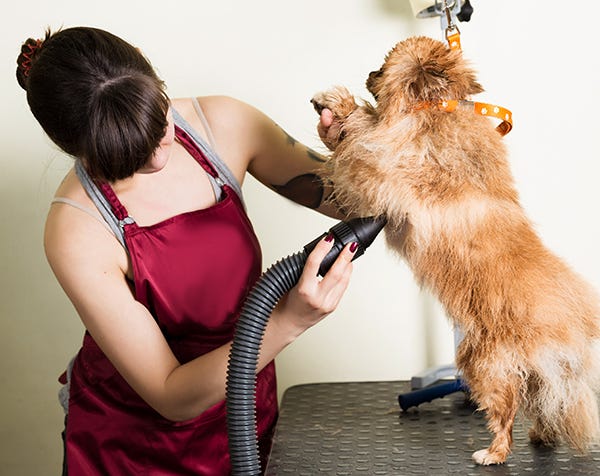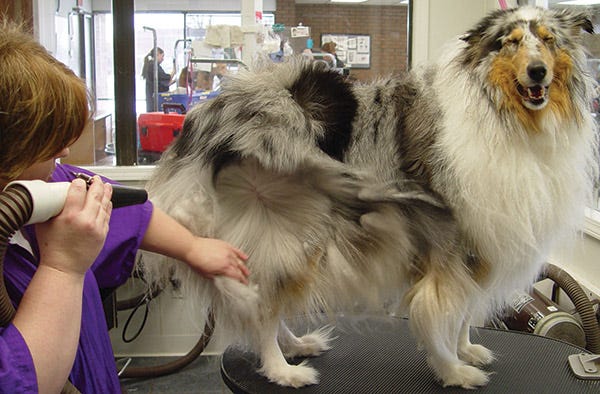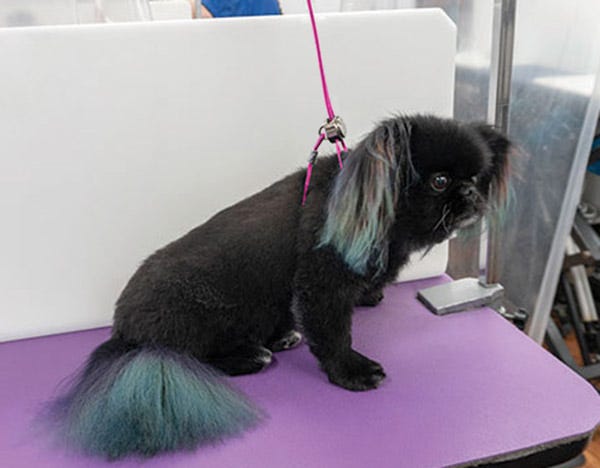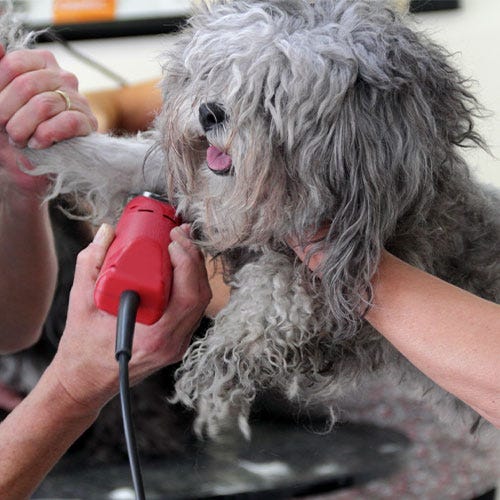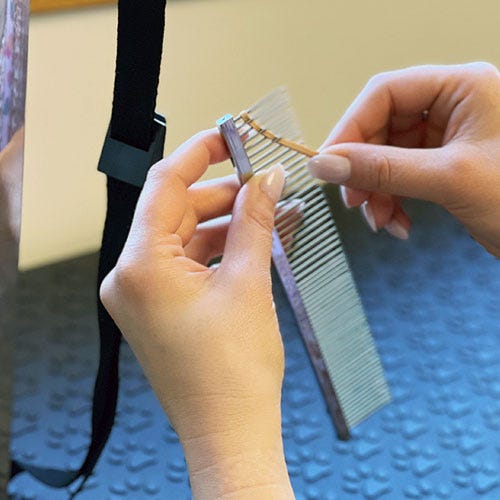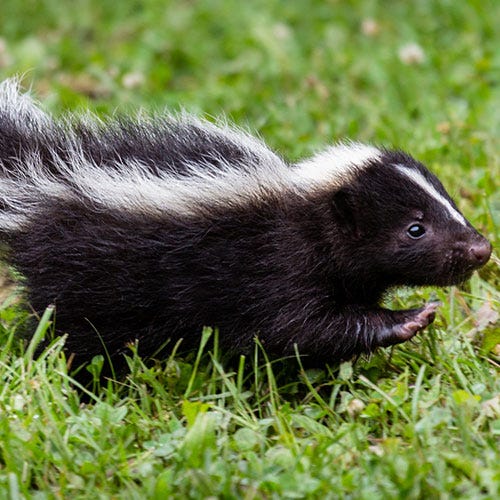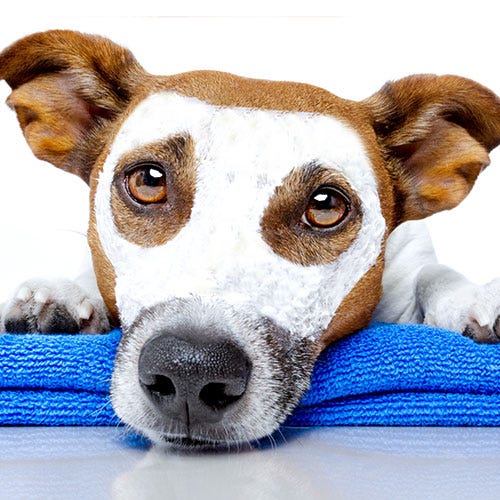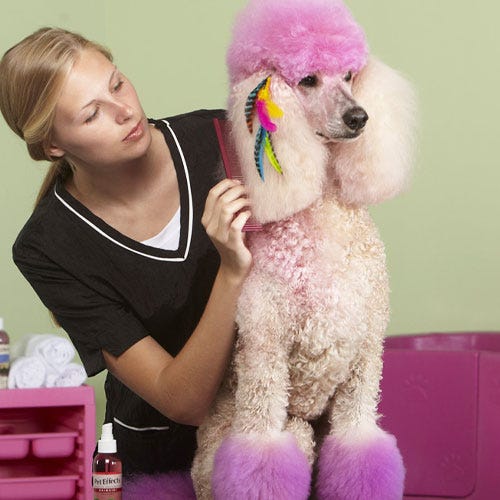Two of the major enemies of pet groomers, heat and humidity can be difficult for groomers to work with. Since Mother Nature won’t just change the weather to suit us, we need to learn how to work around these hazy, crazy, not so lazy summer days.
Heat can be hard on both humans and pets, especially when it’s humid as well. And if it is hot and humid, just think of what we are doing every time we bathe and dry a dog. All of the moisture that we blow off a dog with a high velocity dryer, or mop up with towels or Happy Hoodies? That’s going somewhere and mostly that somewhere is in the air in the salon or van. Steps can be taken to minimize the effects of these conditions.
For you, make sure you are staying hydrated. No matter how busy you are, take time to drink. Water is best. Make it a habit whether you are thirsty or not. Feeling thirsty is a sign that you are already becoming dehydrated – don’t let it get to that point and have to play catch up at hydrating all day. I keep a flip-top water bottle right at my station and fill it a few times a day. Some people don’t like to drink just plain water; if that’s you, find ways to make it more appealing. Add flavoring or a little bit of a sports drink or juice that you like, or drop a few lemon or orange slices in. You know that axiom that the average adult should drink 8 glasses of water a day? A half gallon? You need to drink more than that when it’s hot and humid.
If you feel dizzy or disoriented, have a headache or get cramps in extremities or stomach it can be a sign of heat exhaustion. While not as serious as heatstroke, it isn’t going to do you any good either. Stay hydrated.
What about those furry clients? When you add the stress of being in a salon or van to heat and humidity they may well be in some discomfort. Keep a closer than usual eye on pets in this type of weather. Offer clean, cool water often or if the pet isn’t one that will promptly dump it, keep a bowl available at all times. Some states, counties, or towns may have regulations as to how and when pets in your care should be offered water but you can’t offer it too often under these circumstances.
Make sure bathers are warned to use cooler than usual water temperatures. Dogs generally should be bathed at a slightly lower temperature than humans prefer but during a heat wave barely tepid water is good. (Around 75 – 90 degrees is tepid - which will feel quite cool to a human)
Try and move dogs through as quickly as possible so they spend the least time in the salon and get back to their normal environment. Watch for warning signs such as excessive panting or drooling, very red tinged gums or tongue, lethargy. If you think a dog is stressed you can put a cold towel on them or in their crate to lie on, put a fan directly on them, and call the owner. Keep such dogs in a lower crate; heat rises. In general, avoid dryers with heat as much as possible.
Probably the most important thing to do is try and control the humidity. A dehumidifier is an excellent means to do that. Make sure to get one with large enough capacity to handle not only the humidity generally in the air, but the moisture from a dozen or so wet dogs. Box fans placed so dogs cannot get too close to them help a lot and in fact can be used to dry a lot of coats with no heat at all.
Use product to move things along. If you use conditioner, use a lighter weight one on hot, humid days as conditioners and crème rinses can extend drying time. A quick dry spray after using the high velocity dryer can help or if you don’t have one any silicon based grooming spray will help displace water and speed up the drying process.
Be aware that high humidity will increase the degree of difficulty when prepping curly coats for scissoring and perhaps make owners of those breeds aware that your concern for their pets’ health may mean that the coat is not as completely straight as usual. It isn’t worth risking heatstroke to get a perfect finish. If they are the kind of client that will not be happy with that, perhaps scheduling them on a more temperate day would be the best solution.
Grooming has more regional differences than are usually discussed. I recall, back when I taught grooming, talking to a student who didn’t really understand why dogs had to be totally, completely dry when they left the salon. I used the example of putting clothes away after washing when they were not yet perfectly dry. She still didn’t get it, even after we talked about moisture causing hot spots on dogs with double coats in this kind of weather. No, she wasn’t having difficulty understanding – she was from Arizona, a climate so dry that she did indeed fold and put away slightly damp clothes, which promptly finished drying right in the drawer.
Not everyone needs to know about humidity, but most of these thoughts are relevant to dry heat as well. Awareness of the conditions you and your four-legged clients are in and their response to those conditions is something every groomer should keep in mind.
By Carol Visser, Journalist, Master Pet Groomer, Certified Dog Trainer, Pet Product Expert

